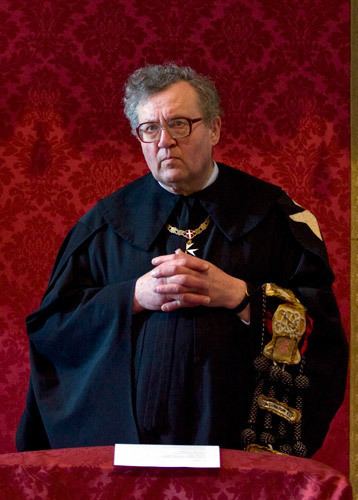 | ||
The Knights of Justice form the first of the three classes of members of the Sovereign Military Order of Malta together with the professed conventual chaplains. They make vows of poverty, chastity, and obedience. "They are religious for all purposes of Canon Law." (Constitutional Charter, Article 9, Par. 1). Unlike most professed members of Catholic religious orders, they are not required to live in community.
Contents
The religious superior of the Knights of Justice, under the Prince and Grand Master, is the Grand Commander, currently Fra' Ludwig Hoffmann von Rumerstein. Most Knights of Justice are members of a Priory or Subpriory. Where there is no priory or subpriory, Knights of Justice are admitted in gremio religionis, reporting directly to the Grand Commander (Code, Article 150, Par. 2).
All Knights of Justice have the title Fra' (an abbreviation for the Latin word frater meaning brother). They are divided into the following ranks:
Until 1989 all Knights of Justice had to be nobles, but since then non-noble Knights of Magistral Grace have been permitted to advance into the category of Justice. The Prince and Grand Master is still elected for life from among the Knights of Justice who have the nobiliary requirements prescribed for the category of Knights of Honour and Devotion.(Constitutional Charter, Article 13, Par. 2).
In 2016 there were fifty-five Knights of Justice. In 1895 there were forty-six, in 1938 twenty-four, in 1968 twenty-three, and in 1986 twenty-four.
Robes
The black church robe worn by the Knights of Justice has a different shape from that worn by the knights of the second and third classes. It is distinguished by the cross of Malta on the left side (not on the centre of the breast). The cross is completely white (not merely outlined in white).
The Knights of Justice in perpetual vows wear an additional garment called a scapular (but different in shape from other monastic scapulars). It is wrapped from the back and rests on the left arm (similar to a maniple). It has four large tassels and is embroidered in gold with the symbols of the Passion of Christ.
The red military uniform of the Knights of Justice is distinguished by a white collar, white lapels and white cuffs. The feathers of the feluca worn by Knights of Justice are white instead of black.
Knights in minority
Until 1961 Knights of Justice could be admitted to the Order in minority, i.e. when they were children. This would give them seniority when applying for commanderies in the Order. Most of these Knights of Justice in minority did not take solemn vows when they became adults.
Prince Nikolaus of Liechtenstein was admitted as a Knight of Justice in minority at the age of three in 1950. The last Knight of Justice in minority was Count Franz-Alfred von Hartig, who was admitted 31 May 1951 when he was sixteen; he is now a Knight in Obedience.
Prominent living Knights of Justice
Other orders of knighthood
The term Knight of Justice is also used for a class of members in several other chivalric orders including the Sacred Military Constantinian Order of Saint George, the Johanniterorden (Rechtsritter), and the Most Venerable Order of the Hospital of Saint John of Jerusalem. However, these knights are not professed religious who have taken the vows of poverty, chastity, and obedience.
